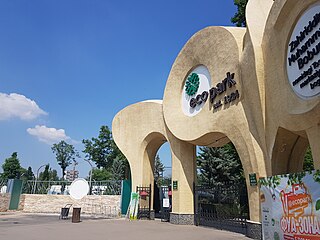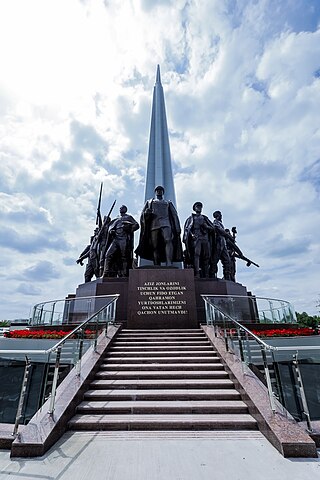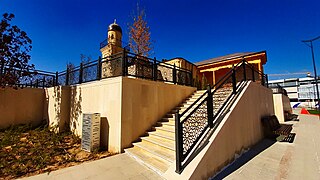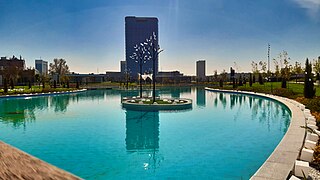
Tashkent, or Toshkent in Uzbek, is the capital and largest city of Uzbekistan. It is the most populous city in Central Asia, with a population of more than 3 million people as of April 1st 2024. It is located in northeastern Uzbekistan, near the border with Kazakhstan.

Tourism represents a substantial and fast-growing sector of the economy of Uzbekistan. The government of Uzbekistan under President Shavkat Mirziyoyev has invested heavily in developing tourism as a high-growth potential industry, resulting in an increase in international arrivals from approximately 1 million in 2016 to 7 million in 2023.

Uzbekistan Super League, known as Coca-Cola Uzbekistan Super League due to sponsorship reasons, is the top division of professional football in Uzbekistan. It is operated under the auspices of the Uzbekistan Professional Football League and Uzbekistan Football Association. It was founded in 1992 and currently has 14 teams. The top team qualifies to the group stage of the AFC Champions League.

The Tashkent Metro is the rapid transit system serving the city of Tashkent, the capital of Uzbekistan. It was the seventh metro to be built in the former USSR, opening in 1977, and the first metro in Central Asia. Each station is designed around a particular theme, often reflected in the station name.

Shohimardon is a village and a subdivision of Fergana District, Fergana Region in eastern Uzbekistan. It is an exclave of Uzbekistan, surrounded by Kyrgyzstan, in a valley in the Pamir-Alay mountains. The name means ‘King of Men’ in Persian. The river Shohimardonsoy flows through the exclave. There are two villages: Shohimardon and Yordon.
Mikhail Yevgenyevich Masson was a Soviet archaeologist. He was the founder of the archaeology school in Central Asia and a professor, doctor of historical and archaeological sciences and member of the Turkmen Academy of Sciences.

The Tashkent–Bukhara high-speed rail line is a 600-kilometre (373 mi) high-speed rail connection between Tashkent and Bukhara, two major cities in Uzbekistan. The route passes through six regions: Tashkent, Sirdaryo, Jizzakh, Samarqand, Navoiy, and Bukhara in Uzbekistan. Trains operate seven days a week under the brand name Afrosiyob. The line originally ran from Tashkent to Samarqand, but an extension to Bukhara went into operation on 25 August 2016. Travel from Tashkent to Bukhara, a distance of 600 km (373 mi), now takes 3 hours and 20 minutes instead of 7 hours.

Visitors to Uzbekistan must obtain a visa from one of the Uzbekistan diplomatic missions or online unless they come from one of the visa exempt countries.

The Museum of Victims of Political Repression in Tashkent is a museum which tells the history of Uzbekistan during the political repression in the Soviet Union, in particular that of the people killed at that time.

Tashkent Planetarium is one of the newest constructions in Uzbekistan, and is visited by local people and tourists. Tashkent Planetarium provides visitors with the opportunity to look at outer space, even in the morning, and enlarge their knowledge about the cosmos and the whole universe.

High speed rail in Uzbekistan currently consists of 600 km of track and services using Talgo 250 equipment, branded Afrosiyob by operator Uzbekistan Railways, on upgraded conventional lines. All HSR lines have been built using upgraded lines on Russian gauge. Other regional railways exist.

The 2018 Uzbekistan Super League was the 27th season of top level football in Uzbekistan since 1992. Lokomotiv Tashkent were the defending champions from the 2017 campaign.

Victory Park, also known as the Victory Park Memorial Complex is a park located in Tashkent, the capital of Uzbekistan. It was planned in honor of the 75th anniversary of the end of the Second World War.

Murod Nazarov is an Uzbekistani businessman and Vice-president of the polo federation of Uzbekistan

Nest One — is a mixed-use development complex in the very center of Tashkent city, the capital of Uzbekistan. Nest One is the tallest tower in Uzbekistan after TV Tower of Uzbekistan. It is a multifunctional skyscraper, 266.5 m high, located on the 4th lot of Tashkent City International Business District (TCIBC).

Tashkent City is a business center under construction in Tashkent. Located in the Shayxontoxur district, between Alisher Navoi Avenue, Olmazor, Furkat streets and Islam Karimov Avenue.

Jahongir Abidovich Artikkhodjaev is former the Mayor (Khokim) of Tashkent City and founder of AKFA Group.

Gayane Umerova is an art critic, curator, and public figure in the field of culture of Uzbekistan.

Murad Buildings is an Uzbek multinational development company located in Uzbekistan. Murad Buildings is one of the largest real estate developers in Uzbekistan, known for Nest One, the tallest building in Uzbekistan, and other major projects.
The Flower Festival in Uzbekistan is an annual spring festival of flowers in Uzbekistan, held in Namangan, Tashkent, Bukhara, Samarkand.































